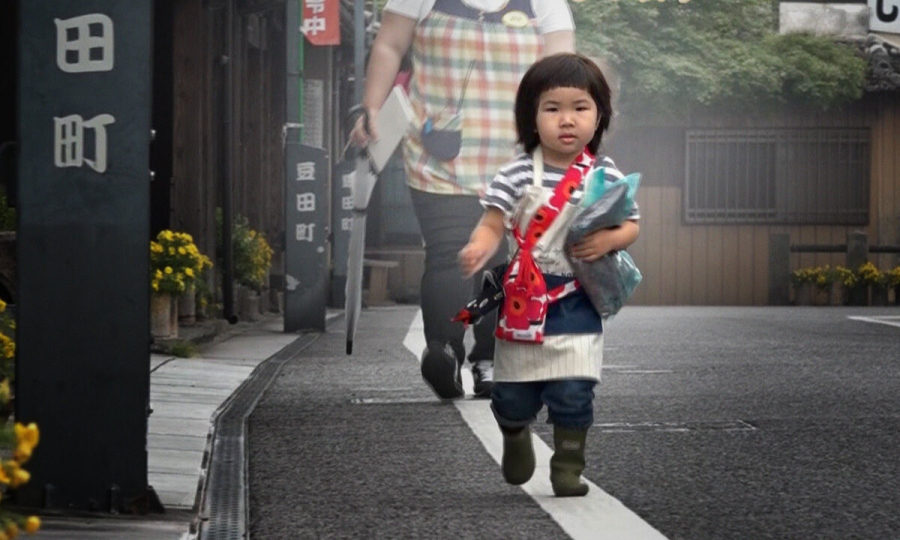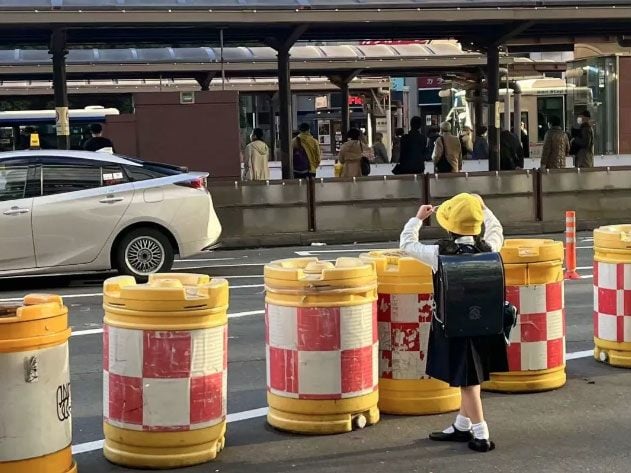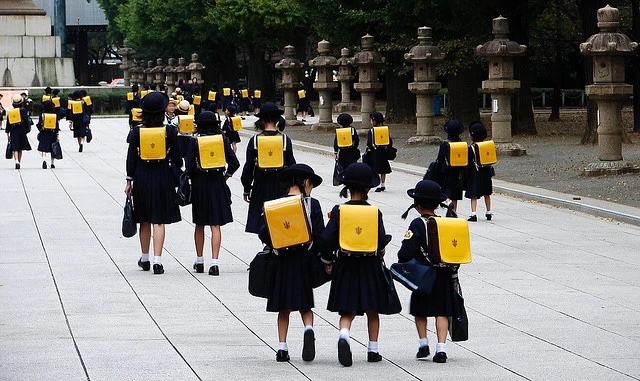One familiar sight you’ll encounter when living in Japan is that of young children, around 6-7 years old, traveling alone on public transportation. These children confidently sit alone on train cars, move in small groups, or are busy looking for a seat.
These kids are dressed in school uniforms, consisting of shiny leather shoes, long socks, pleated skirts, broad-brimmed hats with straps pulled under their chins, and backpacks.
You might wonder: “Where are the parents of these children?” or “How can they navigate public spaces at such a young age without fear?”
Exploring the fascinating insights below will help you find the answers to these questions.
Japanese Children: A Journey Towards Independence from a Young Age
In Japan, there’s a reality TV show called “First Go” that has been running for 29 years. The stars of the show are children between the ages of 2 and 7.
“First Go” captures the experiences of these young children as they venture out on their own for the first time. This could be their initial trip to a store to buy something or to purchase food for their family.
Chinese viewers shared a range of emotions after watching the show: “So touching, full of positive energy, and the children are adorable,” “What a brave child,” “Japanese mothers’ education is really strict, and the children are very well-educated.” Even celebrity guests have teared up multiple times while witnessing the children’s journeys on “First Go.”
Japanese film star Rimi Ishihara, who has appeared on the show, shared: “I couldn’t hold back my tears when I saw the effort of a 3-year-old child going to a store to buy flowers for her mother.”
The little girl Rimi Ishihara referred to is LiLi. LiLi’s task was to go out alone to pick up food that had been ordered in advance and to prepare a gift for Mother’s Day—a bouquet of carnations.
On her first solo outing and errand, LiLi cried and ran to find her father, who was also participating in the show. Before giving her the task, her father stuffed her bag with candies and instructed her: “You must go forward.”
He quietly watched as she left. LiLi turned her head, sobbing, but then bravely continued on, following her father’s instructions. Each time she stopped crying, she would take out a candy from her bag and eat it.
Step by step, the 3-year-old eventually completed her mission. A bouquet of carnations was chosen as the gift for her mother. When he saw his daughter returning with her arms full of things, her father was deeply moved. He shared: “Although I love my child very much, I still want her to do everything by herself, from shopping to carrying things.”
The show’s organizers used hidden cameras to capture the footage. Therefore, during the filming, the children were unaware, and what they displayed in the show was their most natural state.

Japanese Children: A Journey Towards Independence
The Path to Independence for Japanese Children
In 2015, Australia’s SBS TV station aired an 8-minute documentary titled “Japan’s Independence Kids,” which recorded the journey of a 7-year-old girl, Noe Ando, from taking care of her personal hygiene, such as washing her hair and braiding it, to riding the subway to school by herself.
Shinjuku Station, where Noe had to transfer midway, is one of the world’s busiest subway stations, especially during the morning and evening rush hours. This presents a significant challenge not only for children but also for adults, who can easily get lost in the sea of people.
Noe’s mother shared: “She will never learn to solve problems on her own if her parents are always by her side. If she gets lost or takes the wrong train, she must find a way to solve the problem herself.”
This has prompted many parents to ask: Why do Japanese parents let their children commute to school alone?
In Japan, from the very first day of elementary school, most students commute to school by themselves. Those who live nearby walk, while those who live farther away use public transportation. To prepare their children for a smooth school commute, parents need to take care of several tasks before the first day of school, such as:
The Yellow Hat and School Bag
Everyone remembers the small yellow hat that the characters Maruko and Shin-chan often wore in popular manga series. In Japan, these yellow hats are not just fashion accessories; they also play a crucial role in ensuring the safety of elementary school students during their daily commutes.
The yellow color of the hats serves as a warning, making the students more visible as they navigate city streets. This makes it easier for vehicles and pedestrians to spot and pay attention to them, reducing the risk of accidents.
In addition to the hats, Japanese elementary school students also use a special type of backpack, often called a “randoseru.” These bags are designed with smart features such as a sitting pad, convenient shoulder straps, and the ability to rotate 360 degrees, along with other features to ensure the students’ comfort and safety throughout their journey to school.

In Japan, these yellow hats are not just fashion accessories; they’re essential for road safety.
Familiarizing Themselves with the School Route
To ensure the safety of students during their commutes to and from school, the school designates a specific travel route.
About a month before the start of the school year, parents guide their children to familiarize themselves with the route from home to school multiple times so that they can memorize it.
Throughout their 6 years of elementary school, students must adhere to the prescribed route and are not allowed to make changes. If a student needs to transfer schools or move to a new residence, parents must apply for a change of route to ensure the child’s safety.
Learning Safe Road-Crossing Practices
Due to their height, children often fall within the blind spots of vehicle drivers. To ensure their safety when crossing the road, Japanese elementary school students are taught two common practices: raising their hand or using a horizontal flag.
Raising their hand helps drivers easily notice the presence of children. Some children also turn their heads and bow after crossing the road to express gratitude.
Additionally, in areas with wider roads and heavier traffic, small buckets containing cross-shaped flags are usually placed on both sides of pedestrian crossings. When children hold these flags while crossing the road, drivers are obliged to stop and let them pass safely.
Mastering Safety Measures
In Japan, elementary school students’ backpacks are often equipped with alarm whistles, similar to keychains. When in danger, they can press the button to emit a warning sound.
Moreover, some companies sponsor safety devices for students, such as GPS chips, which allow parents and teachers to track their exact locations on their way to school.
To combat child abuse and kidnapping, law enforcement also deploys signs that read “Child Safety House 110” along the routes. This is an initiative by the Japanese police and local organizations to protect children. These signs are placed along the routes frequently taken by elementary school students, and the houses or businesses displaying them are volunteers ready to assist children in emergencies.
Thanks to these measures, the rate of accidents involving children on their way to school in Japan has decreased significantly. This contributes to the trust Japanese parents have in their children’s ability to be independent and in the support of the community around them.
Japanese society always strives to provide the best environment for children to grow up safely and develop a strong sense of responsibility and community awareness. This not only helps children develop independence but also prepares them to become useful citizens in the future. “Trust” and “Responsibility” are the two critical factors in building self-awareness and a sense of collectivism in Japanese children.
Japanese Parents Learn to “Let Go” of Their Children
Wakamatsu, a small girl, wakes herself up every morning to get ready for kindergarten. She takes care of her personal hygiene by climbing onto a small stool to brush her teeth and wash her face. Then, she folds her blanket and puts on her uniform before heading out the door with the bags her mother has prepared. She carries her food and toys by herself without any help from her mother.
Wakamatsu’s mother shared that although her daughter might not do everything perfectly, she has learned a lot from doing things independently. “She’s trying her best to be as helpful as she can today,” the mother said.
Many people question whether this mother’s parenting method is dangerous for her young daughter. The answer is certainly no. The issue lies in the fact that many parents lack the confidence to “let go” and allow their children to do things on their own, as this mother has done.
The educational philosophy of Japanese mothers can be summed up in the following statement: “Raising an 18-month-old child is like raising an 18-year-old adult.” When dealing with an “adult” who is 18 years old, if parents trust their child, they should have the same attitude toward an 18-month-old toddler.
For example, when children participate in household chores, parents encourage and trust that they can complete the task. Or, when children learn to dress themselves, parents should not intervene but believe that their child will dress appropriately. If the child doesn’t do it perfectly at first, they will surely improve over time.
In reality, the relationship between parents and children is a process of mutual exploration and growth. Learning to “let go” is also a form of growth for parents. Through this process, children also learn to grow and become independent.

If they don’t do it perfectly at first, they will surely improve over time.
The Independence of Japanese Children: A Result of a Collaborative Educational Society
In Japan, it’s not unusual to see young children commuting to school or running errands by themselves. This is built upon a foundation of consensus in education among parents and society as a whole.
Since 2008, Japan has identified “life skills” as the fundamental goal of its compulsory education system. Parents here also believe that “letting their children be independent” and truly trusting their capabilities is a sign of strength. Only when parents let go can children have the space to develop their independence.
Japan is a country that frequently faces natural disasters such as typhoons and earthquakes, while also dealing with limited natural resources. Through their struggles with nature, the Japanese have realized that individual strength is not enough to overcome challenges, and cooperation and mutual assistance have become extremely important.
Cultural anthropologist Dwayne Dixon, who has studied Japanese youth, shared: “Japanese children are taught from a very young age about the importance of each community member being able to receive and offer help.”
Japanese children often approach strangers, especially the elderly, for assistance when facing difficulties. In contrast, children in many other countries, including Australia, are taught not to talk to strangers and to always be cautious.
Dwayne Dixon explained: “The Japanese educational system has very unique characteristics. From an early age, children are instilled with a sense of collectivism, a focus on others, and a spirit of serving the community. This concept helps children approach strangers safely.”
When analyzing the reasons behind the differences in children’s behaviors, the key term is “social trust.” Japan has built this sense of trust, which reassures parents when their children integrate into society.







































